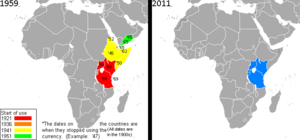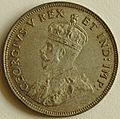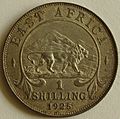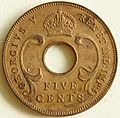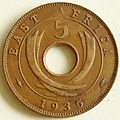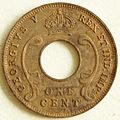East African shilling facts for kids
Quick facts for kids East African shilling |
|
|---|---|
| User(s) | All in the 1900s:
|
| Superunit | |
| 20 | pound (£) |
| Subunit | |
| 1⁄100 | cent |
| Symbol | (none) |
| Coins | 1c, 5c, 10c, 50c, 1/= |
| Banknotes | 5/=, 10/=, 20/=, 100/=, 200/=, 1000/=, 10000/= |
The East African shilling was a type of money used in parts of East Africa that were controlled by the British Empire. It was used from 1921 until 1969. This currency was managed by the East African Currency Board.
The shilling was divided into smaller parts called cents. One shilling was equal to 100 cents. For larger amounts, twenty shillings made up one pound. Today, there's a plan to bring back a new East African shilling as a common currency for the East African Community.
Contents
History of the East African Shilling
The First East African Shilling
In British East Africa, the shilling was the main type of money used. This was a bit unusual because other British areas often used the pound as their main currency. The pound was mostly used for very large amounts of money.
This happened because the first currency used by the British in East Africa was the rupee, not the pound. The East African shilling was introduced in 1921 in Kenya, Tanganyika, and Uganda. It replaced an older currency called the East African florin. Two shillings were equal to one florin. The florin had been created because the value of silver, which the Indian rupee was made of, had gone up a lot after World War I.
The East African shilling was connected to the British shilling. One East African shilling was worth the same as one British shilling. It was also divided into 100 cents. In 1936, Zanzibar also started using the East African shilling. It replaced their old money, the Zanzibari rupee.
After these countries became independent, they started using their own money. For example, Kenya got the Kenyan shilling, Uganda got the Ugandan shilling, and Tanzania got the Tanzanian shilling.
Where Else Was It Used?
The East African shilling was also used in other places. In 1951, it replaced the Indian rupee in the Aden colony and protectorate. This area later became the South Arabian Federation. In 1965, the East African Currency Board stopped operating. The South Arabian Federation then switched to the South Yemeni dinar. One dinar was worth 20 shillings.
The shilling was also used in parts of what are now Somalia, Ethiopia, and Eritrea. These areas were under British control during World War II. Before 1941, they used the Italian East African lira. When Britain took control in 1941, they brought in the shilling. One shilling was worth 24 Lire.
- Italian Somaliland: This area was given back to Italy in 1949. They soon started using a new currency called the somalo, which was worth the same as the shilling.
- British Somaliland: This area became independent in 1960. It joined with what was Italian Somaliland to form Somalia. Somalia then started using the Somali shilling, which was also worth the same as the East African shilling.
- Ethiopia: Ethiopia became independent again in 1941 with British help. They started using the East African shilling. Other types of money like the Maria Theresa thaler were also used for a short time. In 1945, Ethiopia brought back its own money, the Ethiopian dollar. One dollar was worth two shillings.
- Eritrea: Eritrea was taken from the Italians in 1941. It also started using the East African shilling. In 1952, Eritrea joined with Ethiopia. They then started using the Ethiopian dollar.
The Second East African Shilling
There is a plan to create a new version of the East African shilling. This new currency would be used by the countries in the East African Community. These countries include Kenya, Tanzania, Uganda, Rwanda, Burundi, South Sudan, and the Democratic Republic of the Congo.
This new currency was first planned for 2012, but that didn't happen. Then, it was planned for 2015, but that also didn't happen. The current goal is to introduce the new East African shilling in 2024.
Coins of the East African Shilling
The East African shilling had different coins over the years. These coins often featured the image of the British monarch at the time.
Coins During King George V's Rule
| Issued during the reign of King George V | ||||||||
|---|---|---|---|---|---|---|---|---|
| Image | Value | Catalogue number | Details | Design | Years | Notes | ||
| Weight | Material | Front (Obverse) | Back (Reverse) | |||||
| [1] | 1 cent | KM 22 | Bronze | "GEORGIVS V", "REX ET IND:IMP:", crown, value | "EAST AFRICA", value, date | 1922-1935 | Had a hole in the middle | |
| 5 cents | KM 18 | 1921-1936 | ||||||
| 10 cents | KM 19 | |||||||
| [2] | 50 cents 1⁄2 shilling |
KM 20 | 3.8879g | 25% silver | "GEORGIVS V", "REX ET IND:IMP:", picture of King George V | Value, "EAST AFRICA", lion in front of a mountain, date | 1921-1924 | |
| [3] | 1 shilling | KM 21 | 7.7759g | Value, "EAST AFRICA", lion in front of a mountain, date | 1921-1925 | |||
| For table standards, see the coin specification table. | ||||||||
Coins During King Edward VIII's Rule
| Issued during the reign of King Edward VIII | ||||||||
|---|---|---|---|---|---|---|---|---|
| Image | Value | Catalogue number | Material | Design | Years | Notes | ||
| Front (Obverse) | Back (Reverse) | |||||||
| [4] | 5 cents | KM 23 | Bronze | "EDWARDVS VIII", "REX ET IND:IMP:", crown, value | "EAST AFRICA", value, date | 1936 | Had a hole in the middle | |
| 10 cents | KM 24 | |||||||
| For table standards, see the coin specification table. | ||||||||
Coins During King George VI's Rule
As GEORGIVS VI
| Issued during the reign of King George VI (marked as GEORGIVS VI) | ||||||||
|---|---|---|---|---|---|---|---|---|
| Image | Value | Catalogue number | Details | Design | Years | Notes | ||
| Weight | Material | Front (Obverse) | Back (Reverse) | |||||
| 1 cent | KM 29 | Bronze | "GEORGIVS VI", "REX ET IND:IMP:", crown, value | "EAST AFRICA", value, date | 1942 | Had a hole in the middle | ||
| 5 cents | KM 25 | 1936 | Had a hole in the middle | |||||
| KM 25.1 | 1937-1941 | Had a hole in the middle, thicker coin | ||||||
| [5] | KM 25.2 | 1941-1943 | Had a hole in the middle, thinner coin | |||||
| KM 25.3 | 1942 | No hole in the middle, thinner coin | ||||||
| 10 cents | KM 26.1 | 1937-1941 | Some had a hole, some didn't, thicker coin | |||||
| KM 26.2 | 1942-1945 | Had a hole in the middle, thinner coin | ||||||
| 50 cents 1⁄2 shilling |
KM 27 | 3.8879g | 25‰ silver | "GEORGIVS VI", "REX ET INDIÆ IMPERATOR", picture of King George VI | Value, "EAST AFRICA", lion in front of a mountain, date | 1937-1944 | ||
| 1 shilling | KM 28.1 | 7.7759g | Value, "EAST AFRICA", lion in front of a mountain, date | 1937-1944 | Edge pattern was spaced out | |||
| KM 28.2 | 1941 | Rare, thicker edge, larger milling, small design changes | ||||||
| KM 28.3 | 1942-1943 | Central image on the back was redone | ||||||
| KM 28.4 | 1944-1946 | Same as KM 28.1 but with a close edge pattern | ||||||
| For table standards, see the coin specification table. | ||||||||
As GEORGIVS SEXTVS
| Issued during the reign of King George VI (marked as GEORGIVS SEXTVS) | ||||||||
|---|---|---|---|---|---|---|---|---|
| Image | Value | Catalogue number | Material | Design | Years | Notes | ||
| Front (Obverse) | Back (Reverse) | |||||||
| [6] | 1 cent | KM 32 | Bronze | "GEORGIVS SEXTVS REX", crown, value | "EAST AFRICA", value, date | 1949-1952 | Had a hole in the middle | |
| [7] | 5 cents | KM 33 | 1949-1952 | |||||
| 10 cents | KM 34 | 1949-1952 | ||||||
| [8] | 50 cents 1⁄2 shilling |
KM 30 | Cupronickel | "GEORGIVS SEXTVS REX", picture of King George VI | Value, "EAST AFRICA", lion in front of a mountain, date | 1948-1952 | ||
| [9] | 1 shilling | KM 31 | Value, "EAST AFRICA", lion in front of a mountain, date | 1948-1952 | ||||
| For table standards, see the coin specification table. | ||||||||
Coins During Queen Elizabeth II's Rule
| Issued during the reign of Queen Elizabeth II | ||||||||
|---|---|---|---|---|---|---|---|---|
| Image | Value | Catalogue number | Material | Design | Years | Notes | ||
| Front (Obverse) | Back (Reverse) | |||||||
| [10] | 1 cent | KM 35 | Bronze | "QUEEN ELIZABETH THE SECOND", crown, value | "EAST AFRICA", value, date | 1954-1962 | Had a hole in the middle | |
| [11] | 5 cents | KM 37 | 1955-1963 | |||||
| 10 cents | KM 38 | 1956-1964 | ||||||
| [12] | 50 cents 1⁄2 shilling |
KM 36 | Cupronickel | "QUEEN ELIZABETH THE SECOND", picture of Queen Elizabeth II | Value, "EAST AFRICA", lion in front of a mountain, year | 1954-1963 | ||
| For table standards, see the coin specification table. | ||||||||
Coins Issued After Independence
| Issued after countries became independent | ||||||||
|---|---|---|---|---|---|---|---|---|
| Image | Value | Catalogue number | Material | Design | Years | Notes | ||
| Front (Obverse) | Back (Reverse) | |||||||
| [13] | 5 cents | KM 39 | Bronze | "SENTI TANO", 5, "FIVE CENTS", "EAST AFRICA" | "EAST AFRICA", "5", date | 1964 | Had a hole in the middle | |
| [14][15] | 10 cents | KM 40 | "SENTI KUMI", 10, "TEN CENTS", "EAST AFRICA" | "EAST AFRICA", "10", date | 1964 | |||
| For table standards, see the coin specification table. | ||||||||
Krause, Chester L.; Clifford Mishler (2003). 2004 Standard Catalog of World Coins: 1901–Present. Colin R. Bruce II (senior editor) (31st ed.). Krause Publications. ISBN 0873495934.
Banknotes of the East African Shilling
In 1921, the East African Currency Board started printing paper money, also called notes. These notes came in different values like 5, 10, 20, 100, 200, 1,000, and 10,000 shillings. The notes worth 20 shillings or more also showed their value in pounds (like £1, £5, £10, £50, and £500).
In 1943, special 1 shilling notes were printed, but this only happened once. The 1,000 shilling notes were only printed until 1933, and the 10,000 shilling notes stopped being printed in 1947. All the other types of notes were printed until 1964.
The values on the banknotes were written in English, Arabic, and Gujarati. However, the values in pounds were only written in English.
Images for kids
See also


